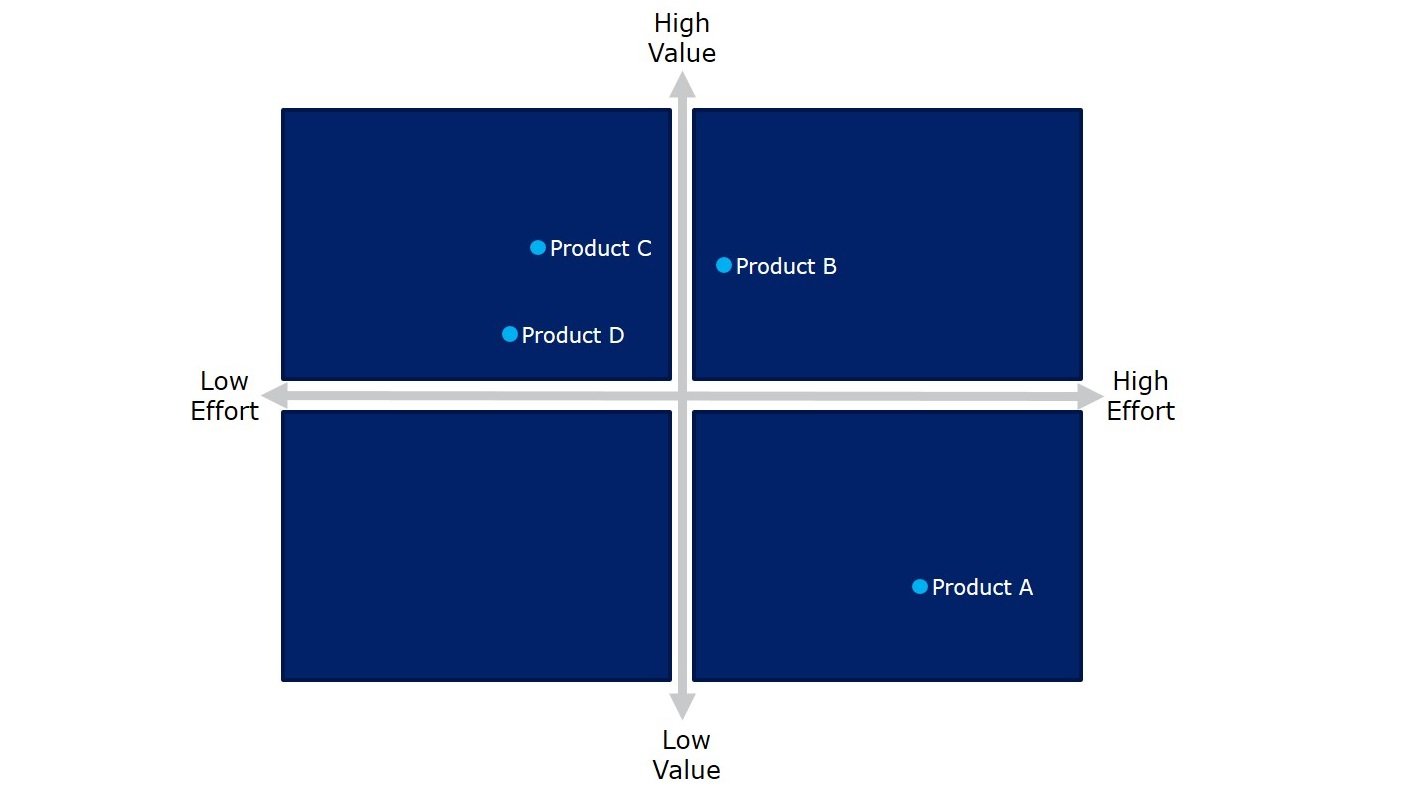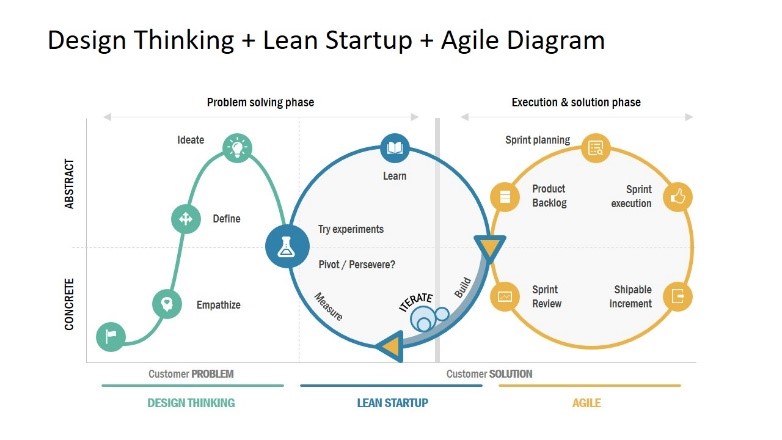No industry or company, large or small, is immune to the
disruptive forces present in our global economy.
Organisations are under immense pressure to quickly adapt to change and embrace innovation. This is becoming part of their DNA in order to stay relevant. Organisational environments need to encourage creativity, team participation and identification of opportunities to enable customer value through continuous learning. These challenges are leading organisations to adopt new ways of working for product innovation in response to change.

A focus on Products over Projects
You may have worked on software development projects where team members from different IT departments delivered a system that had a pre-defined list of requirements, benefits and rigid start and end dates. Traditionally, these projects were large, complex and it was a long time before the product could be used or delivered benefits to the organisation.
Over the years we found organisations shifting their focus to delivering products instead. These products generally deliver meaningful customer experiences, solve a specific customer problem and have shorter time to value compared to long running projects.
These product focused teams:
- Provide transparency and better control over IT budgets
- Are cross-functional and long lived, adopting a continuous process of delivering new features, learning and improving the product over time.
- Yield benefits and Return on Investment (ROI) over shorter time periods when compared to traditional software project teams.
- Adopt capacity based funding that deliver prioritised features.
But how do you ensure that the organisation’s funds and resources are invested to solve the right problem? Is the investment aligned to the organisation's vision and strategy?
Alignment of goals to product innovation
An organisation’s vision, strategy and objectives influences its investment and decisions on product innovation. By an organisation creating strategic principles, it can provide the guardrails necessary to ensure alignment of the organisation’s goals with investment in product innovation.
Importantly, an organisation must also transform the culture to deliver effective outcomes on their product innovation journey.
Lean budgets
We find that traditional budgeting processes, which require detailed business cases to be written, hinder organisational agility. Therefore, we are in favour of leaner budgeting approaches with lightweight business cases, which focus on customer value and outcomes. Lean budgets play a pivotal role to fund long lived agile teams, which are usually tight-knit, high performance and cross-functional when working on a customer centric feature delivery.
Program Backlog
How do you determine if a product should be developed and is what users actually want and need?
A program backlog is made up of a prioritised list of features that enable value for the organisation and are aligned to its strategic objectives. These prioritised features are allocated to long lived agile teams for delivery. A simple yet effective method for prioritisation is to plot features onto a 2 x 2 matrix, which helps the organisation to focus on features that yield the most value to its customers when compared to the effort required to deliver them. Multiple cross-functional teams work on features concurrently from the program backlog to deliver potentially shippable product increments each sprint.

Figure 1. Agile 2 x 2 matrix
Product Discovery
Fast and effective delivery of products to customers that enable incremental value is of high importance for product teams. Research from Forbes has shown that a large number of startups fail because they produce products that nobody wants.
Do these new ways of working allow us to address the right customer problem? Are we able to test and validate concepts and ideas and do so at scale?

Figure 2. Design Thinking + Lean Startup + Agile
Many organisations run a time boxed product discovery process, which brings together the right people to understand and validate customer problems and opportunities. These organisations have an obsession with customer centricity and feedback received in order to continuously learn and improve the product. Organisations can therefore significantly reduce the risk of failing by building the wrong product. Research into product development in Australia has found that many organisations have integrated Design Thinking, Lean Startup and Agile at Scale into their innovation strategies.These strategies are proving to be powerful approaches to achieve business and customer outcomes.
During product discovery Risks, Assumptions, Issues, Dependencies, Decisions (RAIDDs) are created, disseminated and managed.
The features allocated to agile teams from the program backlog are then elaborated into user stories during the discovery process. Discovery being a time boxed event allows the team to validate the customer problem and discover solutions to these problems.
Design Thinking
Use Design Thinking to reduce unnecessary complexity by putting employee and customer experience first. Master Agile to respond faster to changes and accelerate product iteration.
Deloitte, Deliver the Digital Promise
Leading organisations are incorporating design thinking into their operations to meet the changing needs of customers. Design Thinking helps organisations re-imagine the customer experience and identify new business models. Deloitte has identified Design Thinking and agile as 1 of the 8 disruptive forces organisations need to embrace, which are reshaping the way companies create value.
The main focus of the team with this human centred approach is on the customer problem. Empathy maps, customer journey maps and data/ insights are tools that can be used for the team to understand the customer problem and needs. Once the problem is understood, the team is in a better position to come up with ideas using techniques, such as brainstorming, to solve the problem defined.
Tools such as customer journey maps (future state), prototypes and story-boarding are effective ways for teams to visualise and re-imagine the customer experience and test with real users to identify design flaws and usability issues.
Lean Startup
How could you shorten the product development life cycle?
By conducting hypothesis driven experimentation, iterative “product” releases and by utilising the continuous feedback loop to respond rapidly with minimum investment and failure acceptance. This enables organisations to validate learning using a Build-Measure-Learn (BML) feedback loop. A learning canvas is recommended to be created that defines the customer problem, hypothesis to test, objectives and metrics for measurement during experimentation.
The hypothesis in the learning canvas can be created as a Minimum Viable Product (MVP) and tested to learn from user behaviour when they engage with your product. On digital channels, web analytics can be used to measure the clicks on buttons or links in web pages to prove whether the feature is used or not. Once experiments are run, you are able to validate learning and decide whether to continue down a path or change direction with regards to product enhancements.
What is an MVP and why do I need it?
As part of testing and learning when developing products organisations are increasingly investing in developing a Minimal Viable Product (MVP). An MVP is a powerful way to test and validate a hypothesis with real users and customers by obtaining their feedback. As the name suggests an MVP is the minimum product that can be developed earlier, which is made available to the users of your system to verify their interest but importantly that the product is also viable.
Feedback from customers may emanate from multiple channels such as the App Store, Contact Centre or Analytics. Once feedback is received it allows you to improve that product in subsequent iterations, supporting the continuous improvement process. If followed, the Build-Measure-Learn process enables organisations to avoid investing in building features that may not be used. At Deloitte we help clients globally to execute, track and measure lean innovation activity at scale.
Agile at Scale
How do we practically deliver incremental value to customers? Are you able to scale your product development efforts?
Organisations need to become more responsive to change and nimble so that they can innovate and stay relevant. To ensure agility, new ways of working are continuously being adopted throughout the organisation so they are “being agile” when developing products.
A roadmap is developed for the prioritised list of user stories which is based on experiments conducted and scope defined. Agile is focused on the delivery aspect of the solution and the prioritised list of user stories for delivery. The sprint cadence for all agile teams needs to be in sync (E.g. 2 week sprint cycles that starts and finishes on the same day). It is important to have frequent sprint demos for work completed in the sprint by each team, which in some organisations are called showcases. It will provide you with transparency on how much work has been completed in the sprint, regular feedback and a holistic view across the program.
Agile is intended to de-risk the project from the start by early and frequent integration of software source code, automated testing and working software that is demonstrated at the end of each sprint. Tech spikes are used to allow organisations to research various approaches in solution domains. If done correctly, teams are able to build and deliver products incrementally and faster through agile processes.
When you scale agile teams the Scrum of Scrums meeting brings together representatives from each of the agile teams.
Scrum of Scrums meetings help you and the team to
- Co-ordinate and manage dependencies across squads
- Provide visibility into progress towards milestones and impediments
- Ensure alignment between teams
- Resolve blockers
In addition to the Scrum of Scrum another scaling option you could find useful is a Business Scrum meeting, which can be held once a week, where agile team members meet with leadership to unblock issues. Some organisations introduce agile sprints and daily standups in the delivery of projects but this does not necessarily mean that they are following agile ways of working. Agility requires a mindset shift usually starting from senior leadership and new ways of working required across the enterprise to achieve the desired outcomes when building new products.
Once the product is delivered and accessible to customers, the Product Owner is accountable to validate learning as defined in the learning canvas during the discovery phase. Insights on how the system is used will enable the product owner to incrementally improve the product over its lifecycle.
Main roles on the Team
Who are the important members of the team?
It is important for organisations to have the right team members and roles defined to deliver delightful customer experiences and outcomes.

Figure 3. Agile team
Product Owner
To build the right product the Product Owner (PO) is accountable for providing the vision of the product to the team that is aligned to the organisation's goals and representative of the customer. Effective Product Owners are found to demonstrate leadership qualities and need to be empowered, supported, influential and decisive to provide guidance and direction to the team.
Scrum Master and Release Train Engineers
Can impediments be resolved fast enough to ensure continuous flow of value?
The Scrum Master works in agile teams while the release train engineer is accountable for program level features when scaling agile teams. It is important for the runway to be clear for teams to build the product fast, which is facilitated by the Scrum Master and release train engineer by removing impediments.
Both these roles govern the delivery process and help optimise the flow of value at the team and program levels. The Scrum Master oversees the day to day function of the team to achieve sprint goals. They foster an environment that supports high-performing team dynamics, continuous flow and relentless improvement.
Development team
The cross-functional team made up of developers, designers and testers are an integral role to build the product correctly. The development team ensures that the correct architectural patterns and development standards are followed, technical debt is minimised to limit rework of code later on and that code is appropriately tested to address defects.
Conclusion
Creating value delivery ecosystems to respond to disruptive change and support product innovation is imperative for organisations to compete and stay relevant. Integrating approaches such as Design Thinking, Lean Startup and Agile at Scale to create a framework, alongside new ways of working, can enable an organisation to accelerate product innovation and create fast, flexible flow across the enterprise. The framework can be an effective way to lower the risk of failure in product development and increases the chance of building products that users actually want and need.
Organisations can invest funds and resources focusing on customer value and alignment of investment to the organisation's vision and strategy. Developing a Minimal Viable Product (MVP) can enable organisations to test and learn by validating a hypothesis with real users and customers through feedback received. The Product Owner can then continuously improve and enhance the product through long lived agile teams.

.jpg)